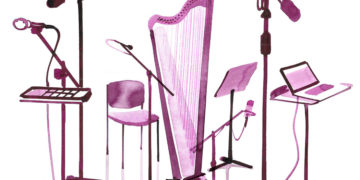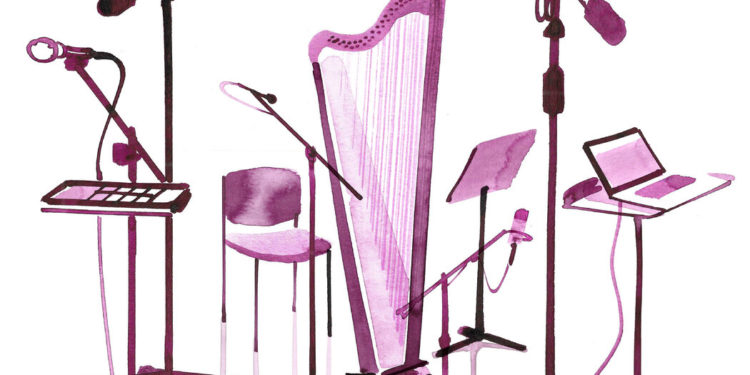I once asked a colleague who runs a concert series what came to mind when he thought of harp music. “A nothingburger,” he replied. I laughed, not because I was shocked but because I agreed.
Sure, I’m a professional harpist. So is my mother. Some of my earliest exposure to music was through classics of our repertoire, and while learning the instrument, I had my steady diet of Saint-Saëns, Debussy, Fauré and Ravel. Frankly, though, all those composers wrote more interesting works for the piano, which is better suited to quick modulations and coloristic variety.
The harp has its hindrances, and a lot of composers are terrified of writing solo music for it. This instrument has 47 strings, each tuned like the white notes of a piano, with the player’s feet delegated the task of engaging flats and sharps using seven pedals. It’s an ingenious design, but only up to a point. Tuning is relatively unstable. The sound is boomy, with metal bass strings that are woofy and indistinct, like organ pedals.
Why bother? Well, I can’t imagine playing the harp without interrogating its potential. If there’s anything I want for my instrument, it’s for there to be a new repertoire worthy of presenting to audiences like that of the piano or the violin. I want the harp to be a site of ingenuity. I don’t want Debussy or Ravel to be the latest composers to have written canonical works for it. Composers and harpists keep trying, but more work still has to be done for the story has to continue.
The harpists who have inspired me traversed new paths. Andrew Lawrence King’s freakishly colorful and delicate recordings on period harps was a game changer in understanding the boundaries of expression in early repertoire. We owe a huge amount to Ursula Holliger, who was responsible for incredible commissions from the likes of Toru Takemitsu, Elliott Carter and Harrison Birtwistle. Take some time and listen to Zeena Parkins’s “Three Harps, Tuning Forks and Electronics,” in which a panoply of extended techniques (a flurry of scratches, fluxes and beatings on the soundboard) are organized into a beautiful and cohesive essay on form.
But there’s always more that can be done. The harp has a remarkably small footprint in the field, whether in funding commissions or presenting concerts. When was the last time you went to a harp show? Could you conceive of a world in which a harp work occupies your attention like an opera or a violin concerto?
That might be a stretch, but I’ve been able to commission music that makes me think it’s possible. It can be difficult to pull off: Commissioning large-scale works requires amassing time, logistical knowledge and financial resources. On May 9, I will perform a recital at 92NY, a program of new and recent works by Artun Çekem, Aida Shirazi and Marcos Balter. I’m waiting on one of four harps to be delivered in preparation for that concert when I could be celebrating my mother’s birthday with my family. There’s trial and error involved, and a risk that not every piece I commission or play is going to stand the test of time. But there are works that I think prove how my instrument is capable of taking a real leap forward.
FOR EXAMPLE, I once plucked up the courage to ask Marcos Balter about composing for harp, and he graciously agreed to speak with me. We ended up creating “Omulu,” in early 2021, for the Miller Theater’s podcast “Mission Commission.” (It will be on the 92NY program.) He asked about the possibility of taking 12 consecutive notes and tuning them each a quarter-tone apart while still letting the pedal mechanism, which is dependent on resistance from the string, to operate properly.
Three days and several hundreds of dollars worth of harp strings later, I figured it out. But in the process, I disfigured my harp to the point of being totally unusable for another work unless I reversed the process. In my mind, the musical result is worth it, but it flies in the face of harp convention. More important, this process opened my mind up to the possibility that, in the instrument becoming more liminal and restricted, the performer might find more freedom of expression.
In 2022, I teamed up with King’s College, Cambridge, to commission “The Street,” with text by Alice Goodman and music by Nico Muhly. I was interested to see what a concert-length work for the harp might look, since we don’t have big cycles like those for keyboard by Messiaen or Ligeti. Because King’s promotes sacred music and has a dedicated festival at Eastertide, it was decided that this piece would take the form of the Stations of the Cross. The result’s beauty and transcendence arise not just from the beautiful harp writing, but also from the incredible texts, which are wordlessly set for the harp to play.
Each movement follows the shape of a spoken meditation, while quoting portions of Gregorian chants that evoke memories of the various liturgies from Holy Week. Playing “The Street” is a surreal experience; it feels like operating some kind of memory machine that has taken the presentations of chant and spoken text, and seamlessly mediated them in real time. Time is suspended as large harmonic gestures hang for long periods without ever becoming stagnant, an effect made even more beautiful when choreographed by Mark Morris, with whom I’ve performed “The Street” twice now. What I love most about the work is that although the harp is a central element, the music or story is not “about” the harp in any way.
The next year, I premiered Josh Levine’s “Anyway,” which was commissioned and presented at IRCAM in Paris. This 35-minute work for harp and electronics demands technology from Camac Harps, in which there is a pickup under every string much like an electric guitar. The intimacy of the piece is almost painful: Every little acoustical nuance is supercharged, making uncomfortably explicit to the audience all of what the harp is subjected to. The teeth of the gears on the strings can be heard with each pedal change, as can the seeming stomping of the feet in complicated passages. So can the tapping of the calluses on the varnished gut strings when I’m preparing to pluck, and each minuscule tuning fault, which can cause intense beating in any of the 180 speakers used at the premiere.
Figuring out “Anyway” required about seven weeks of intense studio time, spread over 18 months, along with months of practicing and fund-raising on my part. Such was the complexity of the work that a technician told me it posed one of the more intricate challenges that he had seen in his many years at IRCAM. For all its pyrotechnics, though, the work has arresting moments of stunning weightlessness as detuned strings at the top of the harp interact with overtones from lower metal strings to proffer slow undulations. The subtle accompanying electronics constitute a duet with the harp, playing with acoustics to make the room feel like it’s moving, even breathing, like a human lung.
OF COURSE, all this takes a lot to put together: having conversations about fund-raising; missing friends’ weddings; lying when a caring partner asks, after a difficult performance, “Are you sure you’re not hurting yourself?”; being honest enough to admit that the loneliness of focusing singularly on promoting and supporting new works of art induces intense depressive episodes.
Six days before the premiere of “Anyway,” I whacked my elbow against a wooden music stand hours before an evening-long dress rehearsal that had been years and tens of thousands of dollars in the making. I made it through that day and the concert, but I wondered whether I’d regain feeling in the ring finger and pinkie in my left hand. The next morning, it was no better, and a friend sternly looked at me over breakfast and told me firmly, but kindly, “It didn’t have to be this way.”
I powered through the next few months, but on the night I was to perform another new work, the numbness in my left hand returned. Soon, I was back in Paris, where I met with an orthopedist who kept a life-size poster of Alain Delon on the wall. I was told I had a pinched ulnar nerve, which would require a two-month break from the harp.
Although I recovered, it took a while for me to learn the lesson that while I can challenge the limitations surrounding the harp, I can only push so hard. And some things are beyond my control. I was planning to bring “Anyway” to my 92NY recital for its New York premiere, but the colleague from IRCAM who coded the electronics was not able to obtain a visa to travel to the United States. There was no other choice but to program something else.
In instances like that, it can be difficult to maintain energy or garner excitement when so much can potentially go wrong. Fortunately, composers are as much of a lifeline as my family, and have helped me learn to ride the waves. After an idealistic stretch in Paris, they helped me get back to New York, somewhat with my tail between my legs. Now, I’m taking a bit of space, and starting a Ph.D. program at Columbia University, before the next round of commissions in 2026. There may be some new constraints on time, but if there’s anything a decade of working with composers has taught me, it’s that boundaries are what force us to be creative.
The post The Harp Needs More Modern Music. That’s Easier Said Than Done. appeared first on New York Times.



















